Last updated on December 31st, 2013
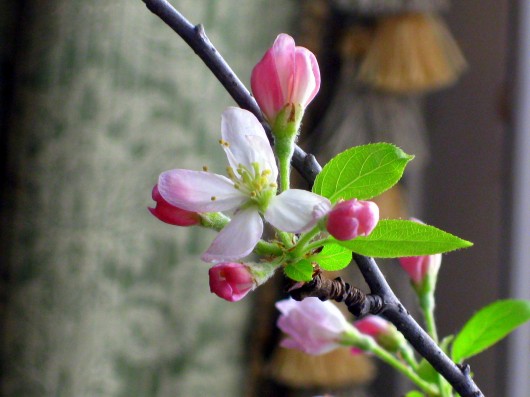 HERE IN COLD, ZONE 5-B, February brings Valentine’s Day…and lots of fun gardening chores. Outdoors, there are seeds to sow ( regardless of the temperature), and certain trees and shrubs to prune. And indoors, there are African violets to propagate, seeds to test, and branches (like crabapple, pictured above) to force into glorious, early bloom:
HERE IN COLD, ZONE 5-B, February brings Valentine’s Day…and lots of fun gardening chores. Outdoors, there are seeds to sow ( regardless of the temperature), and certain trees and shrubs to prune. And indoors, there are African violets to propagate, seeds to test, and branches (like crabapple, pictured above) to force into glorious, early bloom:
Winter-Sowing: If you haven’t already sown your perennials outdoors in milk jugs or other containers, better get hopping. Some require a number of freezes and thaws, or “cold-stratification,” in order to germinate. New to this nifty method of seed-sowing? Check out Winter-Sowing 101.
Seeds: Order from catalogs now, especially if you have specific colors or varieties in mind. I learned the hard way that choice varieties often sell-out by March. And if you have extra annual and vegetable seeds held over from last year, make sure they are still viable before you plant them. My easy seed-testing guide.
 Flowering Branches: Need colorful bouquets for the house? Clip the branches of spring-flowering trees and shrubs. Witch hazel, crabapple, and forsythia will all bloom in the warmth and light of your windows now. My forcing routine.
Flowering Branches: Need colorful bouquets for the house? Clip the branches of spring-flowering trees and shrubs. Witch hazel, crabapple, and forsythia will all bloom in the warmth and light of your windows now. My forcing routine.
Plan ahead for March. Before spring — and utter chaos — arrives, order fertilizers, mulching material, stakes, plant ties, and tools if you need them. It’s so much easier to start equipped than to have to await some necessary item just when you need it most.
 Save Your Wood Ashes. If you use fireplaces to heat your home — I do — you will find in your wood ashes a valuable soil amendment called Potash. I swear that regular ash-applications are the reason my lilacs and peonies bloom so well each spring. More details about this natural soil-sweetener.
Save Your Wood Ashes. If you use fireplaces to heat your home — I do — you will find in your wood ashes a valuable soil amendment called Potash. I swear that regular ash-applications are the reason my lilacs and peonies bloom so well each spring. More details about this natural soil-sweetener.
Raised Vegetable Beds. Top these off with shredded leaves, as I do, and you won’t have to buy additional soil later on. A light sprinkling of nitrogen-rich cottonseed-, soybean-, or alfalfa- meal will hasten the leaves’ decay.
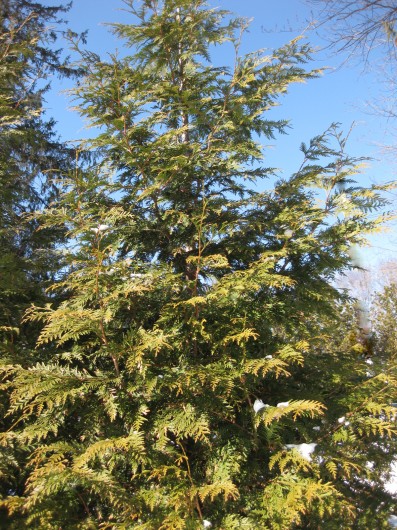 Screening. Before trees leaf out, take a good look at your property. Are there any eye-sores (like a neighbor’s trash can) you’d like to screen out? Now is the time to notice which evergreen trees or shrubs can frame your property, and transform it into the private sanctuary it ought to be. I used Thuja ‘Green Giant’ to make my neighbors disappear.
Screening. Before trees leaf out, take a good look at your property. Are there any eye-sores (like a neighbor’s trash can) you’d like to screen out? Now is the time to notice which evergreen trees or shrubs can frame your property, and transform it into the private sanctuary it ought to be. I used Thuja ‘Green Giant’ to make my neighbors disappear.
Pruning. Some warmish day when you won’t hate the job, start pruning your trees and late-blooming shrubs. Always prune with a purpose, such as: to get rid of dead or broken branches; to make plants more shapely; or to admit sunlight to areas beneath. In other words, don’t just saw off tops!
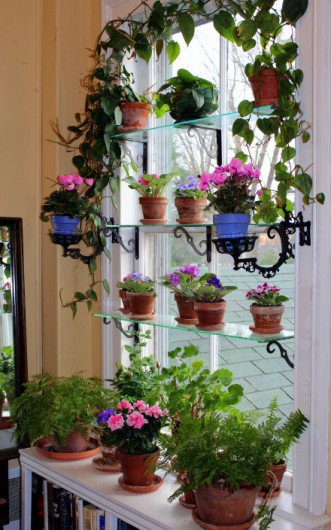 Houseplants need attention, too:
Houseplants need attention, too:
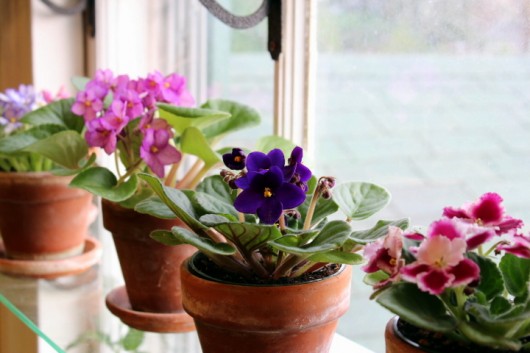 African Violets. Now is a great time to propagate this beautiful Saintpaulia ionantha. A single leaf potted in February will give you at least 8 clones of blooming-size by October. Details and pictures.
African Violets. Now is a great time to propagate this beautiful Saintpaulia ionantha. A single leaf potted in February will give you at least 8 clones of blooming-size by October. Details and pictures.
Amaryllis. Cut away the faded flowering stem if your new plant has bloomed. Continue to tend it in the window. Feeding goes on until late in August. Your older plant might be ready to emerge from the cool, dark cellar now; check the bulb for a green tip. And by sure to read my amaryllis growing-guide.
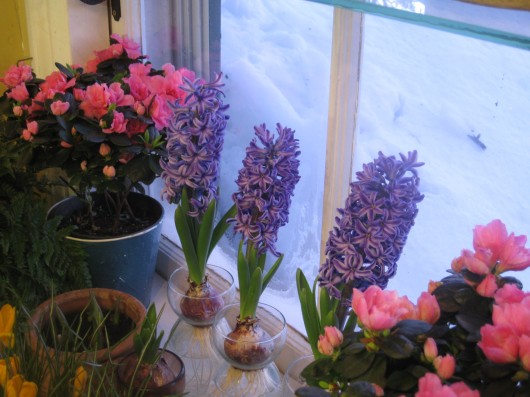 Bulbs. Bring the remaining hardy bulbs you are forcing out of cold storage, and give them a position in warmth and light. If you provide food and water after flowers fade, your bulbs can have a fine future in the garden outdoors. You can find all of my bulb features here.
Bulbs. Bring the remaining hardy bulbs you are forcing out of cold storage, and give them a position in warmth and light. If you provide food and water after flowers fade, your bulbs can have a fine future in the garden outdoors. You can find all of my bulb features here.
Cyclamen. As some flowers fade and some leaves discolor, yank both out from the base of the plant. Remember to water from beneath. Be sure to feed the plant regularly, too, but only if you intend to keep the tuber for an encore performance next winter. How to grow and re-bloom this great plant.
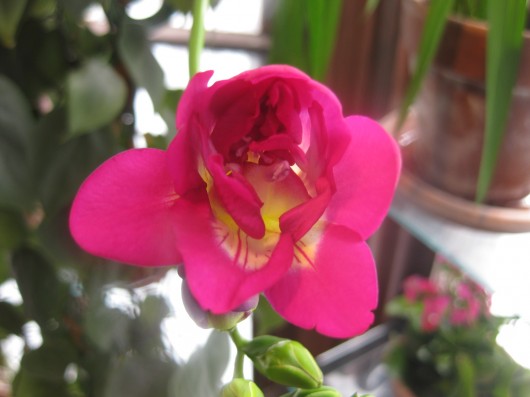 Freesia. This is the big month for colorful, fragrant freesia. Water the bulbs daily, and be sure to visit my freesia forcing-guide.
Freesia. This is the big month for colorful, fragrant freesia. Water the bulbs daily, and be sure to visit my freesia forcing-guide.
Geraniums. Those you’ve grown from September cuttings are probably setting bud now. I pamper mine with high-phosphorous food, at the rate of a 1/4 teaspoon per gallon of room-temperature water.
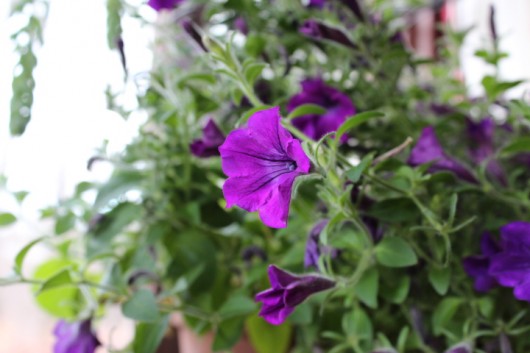 Petunias. Overwintered specimens, if placed in your sunniest window garden, will bloom with utter exuberance now. Provide food and water freely.
Petunias. Overwintered specimens, if placed in your sunniest window garden, will bloom with utter exuberance now. Provide food and water freely.
Primroses. Hopefully your florist will have these enchanting plants this month. Why not send yourself a Valentine of three misty lavender P. malecoides? This “Fairy” primrose will stay handsome for weeks, and while in bloom will require only light, not sun. I always enjoy a winter fling with primroses.
Sweet Olive. If leaf tips turn brown, you are either overfeeding the plant, or your tap water contains too much fluoride. Feed no oftener than once each month, and use distilled water if your tap is suspect.
Are my monthly lists of chores helpful to you in some small way? Perhaps you can let me know by leaving a comment. As always, I love to hear from you.
Don’t miss anything at A Garden for the House…sign up for Kevin’s weekly newsletter.

Nancy H. says
My “brown thumb” has been slowly turning more green these last few years and reading about all of your indoor winter plants is so inspiring! Thanks for all the great ideas! Looking forward to trying the ashes on lilacs trick and very interested in looking into the Green Giants.
june says
Hi Kevin, I enjoy all your flowers but in particular,looking out the window ,seeing the change in season..Wonderful to see all the snow along with the beauty of spring with all the colour… kinda brings the poetry out in the season…Ty
Kevin Lee Jacobs says
Hi Nancy H. – So glad you found this list helpful.
june – Forced bulbs, flowering branches, and too-many houseplants make winter bearable for me! So glad you enjoyed the photos.
peg says
you are my garden and kitchen rock star!!
Cary says
Delightful post. Thanks for the reminder that wood ash helps peonies and lilacs. I’ve been spreading them in the veg garden, but had forgotten that lilacs and peos like it too. I used to use rabbit food pellets as a jump starter for my compost heap decades ago and for some reason stopped. Now I ‘d like to buy some alfalfa meal to add to my brown leaves topping my veg beds (thank you Kevin :)!), but wonder if you have other uses for alfalfa meal. Thanks for this great list of Feb chores. Fun times!
CheyAnne Sexton says
your tips are awesome. so much to remember and you do a terrific job of that. Makes me want a window like you do.
peace n abundance,
CheyAnne
Kevin Lee Jacobs says
peg – I’m blushing.
Cary – Alfalfa meal is a great fertilizer for plants that prefer soil on the alkaline side. Hostas, lilacs, and roses, to name just three.
CheyAnne Sexton – Nice to meet you. It’s very easy to outfit a window with glass shelves. The directions are here.
Wendy says
Hi Kevin,
I have an ugly vinyl fence I need to hide. The bit of yard it lines is wet.
Any good ideas for what I could plant and disappear the fence?
Many thanks for any suggestions!
Wendy
Kevin Lee Jacobs says
Wendy – Three questions for you: 1) Which plant hardiness zone (or region) are you located? 2) Is the soil soggy, boggy, or merely damp? 3) Are we talking about sun, part sun, or shade? Provide these answers, and I’ll try to come up with some concealing vines for you.
Elizabeth says
Hi Kevin,
I am thoroughly enjoying your website & am learning new things about plants & their care.
Regarding the winter sowing, I was wondering if clear plastic water bottles would be OK. They are the same type a you show but made of clear plastic. Wondered if they would let too much sun in or does this matter? Also enjoy your recipes & seeing your beautiful home.
Thanks for a great site.
Elizabeth
Wendy says
Hi Kevin,
I’m in zone 6b.
The fence runs the length of our small yard. It has morning and afternoon sun. I would say the soil is soggy. (the mower leaves ruts when I mow) It’s a small wedge with drainage problems. The yard slopes up away from the house and a little more than slightly.
I purchased the house last spring. The vinyl fence is high (7ft?) and is an awful not yellow, not off white color. It runs up the yard and ends at a shed which is an awful not yellow. not off white color. It all matches the color of the siding on the house, which is a 100 year old twin.
One of the sadder things is there was an old, climbing rose at the bottom of this hill. It had branches which were an easy 3 inches around and climbed up a trellis next to the patio. At one time, it had been well taken care of; the soil here was grated nicely and the trunk had a great open space. The people I bought the house from (they lived here only three years) hatched it back, and let the space go to weed so that it held the moisture. I cleaned it all out and I am hopeful the vine will come back; that maybe it is still alive beneath the ground.
Anyway, thank you so much for your time.
Wendy
Barbara says
Just recently found your site from Pinterest and am excited to receive your newsletter. You’ve inspired me to try African Violets again. Never have had sustained success with them tho my Grandma always had lots of them on the farm. Sooo, I’m am going to follow your suggestions and try again. Love your site. Barbara
PaDort says
Love your black iron pot holders on each side of your window. Now that was a find! It’s gorgeous accent.
Kevin Lee Jacobs says
Elizabeth – Water bottles (or gallon-size jugs) made of clear plastic are ideal for winter-sowing. Have fun with your project!
Wendy – Scrape off a little bark from a stem on your rose shrub. If you see green beneath the bark, the shrub is definitely still alive.
As for your fence situation, there are not many vines that can handle soggy soil. But here’s what I would do: dig a 3-feet wide by 1-foot deep hole every six feet along the fence. And when spring seems a fair certainty, place one ‘Heavenly Blue’ morning glory seed (or seedling) in each hole. Within 8 weeks, your fence will be smothered with gorgeous, heart-shaped green foliage. And the blue, trumpet-shaped flowers will compliment the yellow of your house.
Of course, this is only a quick, annual solution. For more permanent coverage, obtain a considerable quantity of excellent soil, and pour it as a foot-tall raised bed (or berm) along the fence. Then you can grow any concealing vine your heart desires. Hardy kiwi comes to mind — I have it on a pergola in my Kitchen Garden.
Wendy says
Where did you ever get the idea for Hardy Kiwi? I’ve been looking it up – how cool is that?!
I like the idea of the Morning Glories for right now. I’ll run some wire up the fence while searching for some reasonably price soil.
Thank you very very much!
Wendy
Antoniette says
Thanks for the tip on the forsythia. About 8 days ago, I clipped some branches that had teensy tiny beginnings of buds. Put them in a vase of water, and viola, yesterday they opened into lovely yellow sprays of sunshine in the house.
I really enjoy your blog Kevin, and especially like the fact that you serve reminders for what I should be doing, and when. It really helps me stay on task! Thanks!